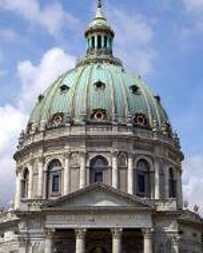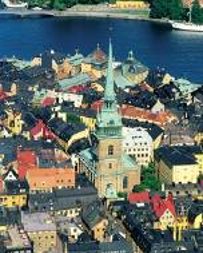Copenhagen, Denmark
Copenhagen was founded during the 12th century. The city owes much of its charm to the buildings erected by Denmark's monarchs, and boasts a treasure trove of late-Renaissance and Rococo architecture.
Copenhagen deserves its accolade as the Venice of the North. Founded on a series of islands and islets, the city today is laced with graceful canals and boasts some of the most delightful architecture in Northern Europe. See the fabled statue of Hans Christian Andersen's Little Mermaid, a symbol of the city. Stroll along the old harbor of Nyhavn, lined with cafés, restaurants and 500-year-old gabled houses. Browse the superb shops on the world-famous Stroget or view the Rococo palaces lining Amalienborg Square. Best of all, savor the taste of local delicacies while wandering the paths of Tivoli Gardens, one of Europe's most celebrated pleasure gardens.

Oslo, Norway
Forest-clad slopes plummet to an island-studded fjord. Welcome to Oslo, Scandinavia's oldest capital city. The commercial center of Norway, Oslo has been a major trading port for over a millennium. Its harbor is crowded with shipping that ranges from cruise ships to workaday shrimp boats. Though a relatively modest city in size - some 550,000 Norwegians call it home - Oslo is one of the largest capital cities in the world in terms of area. The hills and lakes of its outlying countryside are a paradise for lovers of winter sports. And the city itself boasts a sophisticated yet cozy charm, with a blend of 19th- and 20th-century buildings, many decorated with woodcarvings and bright frescoes, and wide avenues dotted with public squares and parks.
Oslo is the least populous capital in Scandinavia. The city offers excellent theatre, great cafés and quality
shopping.
Aarhus, Denmark
It's easy to assume that Aarhus stands in Copenhagen's shadow - Aarhus after all is the second largest city in Denmark, and its university is both the country's second oldest and second largest. Yet Aarhus boasts singular virtues and charms. Despite a relatively modern cityscape, Aarhus is the oldest city in Scandinavia, mentioned in Icelandic sagas and chronicles. Excavated glass pearls and rune fragments date the city to centuries before its official founding in 770. Aarhus also boasts a lively cultural scene with an acclaimed International Art & Culture Festival in late August. It is also rich in parks and green areas. Located on Jutland's east coast, Aarhus is surrounded by dense forests, and provides easy access to Denmark's scenic Lake District west of the city.
Originally constructed in the 12th century, Aarhus's Domkirke is one of the great cathedrals in Scandinavia. Its immense copper spire stands over 300 feet high, making it - ironically - the second tallest bell tower in Northern Europe.
Berlin (Warnemunde), Germany
Berlin is a worthy rival to London or Paris in terms of history, art and culture. The city's highlights include the restored Reichstag Building with its magnificent glass dome and the stunning Pergamon Museum.
Warnemünde is a seaside resort near the harbor entrance to Rostock, one of the city-states that formed the medieval Hanseatic League. Originally a fishing village turned spa and resort. Explore the old Cold War hot spots and view the Brandenburg Gate, restored to its original magnificence. Or, stroll along the Kurfurstendamm and take coffee in a local cafe. Warnemünde is also your gateway to Mecklenburg and the German countryside.
Helsinki, Finland
Perhaps their country's harsh climate encouraged the Finns' love and respect for design and the arts. Whatever the cause, there's no denying that Helsinki is one of the most vibrant and beautiful cities in Scandinavia. Hailed as the "Daughter of the Baltic," Finland's capital is a city of graceful neoclassical buildings, striking modern architecture and spacious boulevards dotted with squares and parks. In the past century, Finland has nurtured some of the major creative talents of Western culture, from the composer Sibelius to architects Eliel & Eero Saarinen and Alvar Aalto.
The center of Finnish commerce and culture, Helsinki is home to some 590,000 people. Much of the city's neoclassical architecture dates from the period of Tsarist rule, which began in 1809 after political control of Finland passed from Sweden to Russia.
St. Petersburg, Russia
St. Petersburg has provided a historic stage since the day Peter the Great ordained its construction on the banks of the Neva. In its relatively short history - the city is younger than New York - St. Petersburg has witnessed the rise and fall of Imperial Russia, three shattering revolutions, and civil war. The city survived a long and tragic siege during World War II - indeed St. Petersburg became a symbol of Russian resistance to Nazi invasion.
Russia's "Window on the West," St. Petersburg remains one of the world's most beautiful metropolises. Perched on the banks of the Neva, the city is crisscrossed by canals. Two great architects helped bring Peter the Great's vision of St. Petersburg to life: Rastrelli and Carlo Rossi. The rich architecture that resulted features a mixture of styles from ornate Russian Baroque churches to neo-classical palaces. St. Petersburg has also been the cultural soul of Russia, a repository of priceless art and a home to poets, musicians and composers ranging from Pushkin to Shostakovich.
Peter the Great instilled his near-mania for architecture and building in his successors, making the then capital of Imperial Russia one of the architectural treasures of the world.
Tallinn, Estonia
Like Latvia and Lithuania, the Baltic republic of Estonia has survived a turbulent history. The small nation was conquered and ruled by the likes of Teutonic Knights, Polish princes and Russian Tsars. For 51 years, Estonia remained a pawn in the Soviet empire, until the burgeoning freedom movement led to independence for the Baltic Republics in 1991. Like its sister republics, Estonia maintained its ties to the Western tradition, retaining the Latin alphabet and Catholic and Protestant faiths. Once a member of the historic Hanseatic League, Tallinn is the political, commercial and cultural center of Estonia.
Stockholm, Sweden
Often described as the "Capital of Scandinavia," Stockholm traces its origins back seven centuries, when it was founded on the island of Gamla Stan and became the capital of Sweden. Today, the city covers 14 separate islands connected by bays, channels and inlets. The skyline is a sea of copper roofs grown green with patina, towers, spires and graceful cupolas stand sentinel over the historic Old Town (Gamla Stan). With its population of nearly a million people, Stockholm is one of the world's most beautiful, clean and orderly cities.
With a history stretching over seven centuries, Stockholm is not just a beautiful city but also Sweden's center of art and culture.









No comments:
Post a Comment